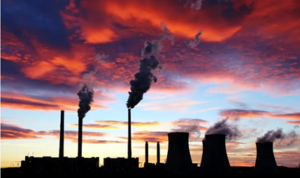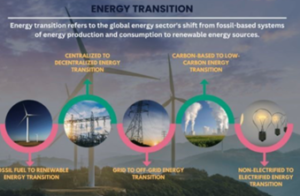Transition without playbook.
Shifting away from fossil fuels will require mediating domestic and international conflicts, facilitating global cooperation, and building new institutions.
Relevance
- GS Paper 3
- Conservation, environmental pollution and degradation, environmental impact assessment.
- Tags: #fossilfuel #climaechange #COP #currentaffairs #upsc.
Why in the News?
Quarter 1 economic indicators are released by government.
- The global shift away from fossil fuels towards clean energy sources is a complex and pressing challenge.
- While the solutions may seem straightforward on the surface, their implementation requires overcoming domestic and international conflicts, fostering global cooperation, and establishing new institutions to drive this transformative process.
The Complexity of the Energy Transition
- The energy transition is a monumental undertaking. It involves reshaping a $100 trillion global economy heavily reliant on fossil fuels into one driven by clean energy.
- The broad strokes of the roadmap are clear: electrify industrial and transportation systems, reduce the cost of energy generation and storage, upgrade infrastructure, and develop innovative financing mechanisms.
- Furthermore, energy conservation and efficiency must be integral to all initiatives. However, these solutions, while technically sound, may not be sufficient to meet the urgent need to limit global temperature increases to 2 degrees Celsius or, ideally, 1.5 degrees Celsius, as agreed upon at COP21 in 2015.
The Lack of Conceptual Clarity
- One significant challenge lies in the terminology itself. The phrase “green energy transition” lacks conceptual clarity.
- It implies a complete shift from one energy source to another, which isn’t the reality of the green transition. Instead, it involves a gradual decline in the market share of fossil fuels until clean energy dominates.
- This mirrors historical energy transitions, such as coal replacing wood in the 18th century and oil overtaking coal in the 20th century. These transitions added new fuels rather than entirely replacing existing ones.
Distributional Consequences
- Moreover, the transition has distributional consequences. It won’t be socially neutral, leading to winners and losers in various sectors.
- For instance, coal miners and oil rig workers may face job displacement, while engineers specializing in clean energy technologies will be in demand.
- Governments must make difficult choices about how to distribute the costs and benefits of this transition, which is integral to energy security and political stability.
Political Challenges
- Politically, acknowledging these realities can be difficult for leaders. They often choose not to openly discuss the challenges associated with the transition, inadvertently suggesting that a rapid leap is possible.
- Instead, leaders should emphasize the need to address multiple barriers, including geopolitics, vested interests, finance, and competitiveness, which currently impede the transition’s pace.
The China-West Divide
- Another critical aspect is the emerging division between China and the West, marked by their respective control over essential transition minerals and advanced technology.
- China leads in the supply of minerals like lithium, nickel, cobalt, and copper, while the West possesses advanced technology and equipment.
- Both entities aim to avoid dependency on each other but recognize their mutual interdependence. This dynamic requires strategies focused on “de-risking” rather than “decoupling,” emphasizing the need for “multi-alignment” in countries like India, which must navigate relationships with both blocs.
The Need for a Playbook
- In the midst of these challenges, the absence of a comprehensive playbook for the energy transition becomes evident.
- There is no established framework to guide the process, facilitate international cooperation, develop essential skills, transfer technology, or mediate conflicts that inevitably arise.
- To successfully accelerate the green energy transition, new institutions must be established. These institutions should serve as hubs for global cooperation, foster skill development, facilitate technology transfer, and mediate domestic and international conflicts.
- Only through such a concerted effort can we hope to achieve the necessary transformation and mitigate the climate crisis.
The transition to green energy is not a simple, clear, or wrong solution, but it is an immensely complex challenge. To overcome the barriers and accelerate the transition, the world needs more than just technical solutions. It requires the establishment of institutions and a playbook that can mediate conflicts, promote cooperation, and ensure a just distribution of the costs and benefits of this profound transformation. Only with these mechanisms in place can we hope to address climate change and secure a sustainable energy future for all.
| Types of energy transition
1. Fossil Fuel to Renewable Energy Transition: – Shift from coal, oil, and gas to renewable sources: wind, solar, hydro, geothermal, and biomass. 2. Centralized to Decentralized Transition: – Move from large power plants and long-distance transmission to small-scale renewables. – Utilize rooftop solar panels and small wind turbines. 3. Grid to Off-Grid Transition: – Transition from the conventional electrical grid to localized, off-grid systems. – Enable homes, businesses, and communities to generate power locally with renewables. 4. Carbon-Based to Low-Carbon Transition: – Reduce carbon emissions in the energy sector. – Embrace cleaner, low-carbon sources like solar, wind, and nuclear power. 5. Non-Electrified to Electrified Energy Transition: – Extend electricity access to underserved areas. – Replace non-electrified sources like kerosene lamps and diesel generators with solar and wind power. Efforts 1. India’s Ambitious Renewable Energy Target: – India set a goal to reach 450 GW of renewable energy capacity by 2030. 2. Production Linked Incentive Scheme (PLI): – The Government of India introduced the PLI scheme to boost the manufacturing of raw materials for renewable energy. 3. PM-KUSUM Initiative: – PM-KUSUM aims to provide financial and water security to farmers. – It targets harnessing 25,750 MW of solar energy capacity by 2022. 4. Solarization of Water Pumps: – Distributed power delivery to consumers through solar-powered water pumps. 5. Akshay Urja Portal and IRIX Portal: – Ministry of New and Renewable Energy hosts these platforms. – IRIX facilitates idea exchange among energy-conscious Indians and the global community. |
Sources: https://epaper.indianexpress.com/3757622/Delhi/September-04-2023#page/11, Sansad TV, https://thehill.com/opinion/energy-environment/581256-how-to-transition-away-from-fossil-fuels-without-creating-an/.
Mains Question
Examine the political challenges while addressing the complexities of the energy transition. How can acknowledging these challenges contribute to a more effective and transparent transition process? 250words.





